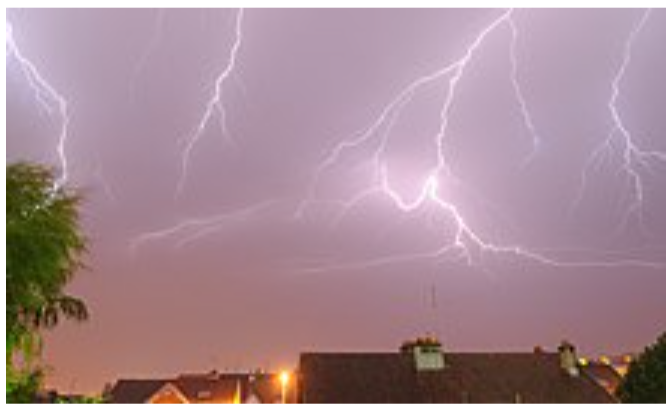Lightning is a naturally occurring electrostatic discharge during which two electrically charged regions, both in the atmosphere or with one on the ground, temporarily neutralize themselves, causing the instantaneous release of an average of one gigajoule of energy.
This discharge may produce a wide range of electromagnetic radiation, from heat created by the rapid movement of electrons, to brilliant flashes of visible light in the form of black-body radiation. Lightning causes thunder, a sound from the shock wave which develops as gases in the vicinity of the discharge experience a sudden increase in pressure. Lightning occurs commonly during thunderstorms as well as other types of energetic weather systems, but volcanic lightning can also occur during volcanic eruptions.
The three main kinds of lightning are distinguished by where they occur: either inside a single thundercloud, between two different clouds, or between a cloud and the ground.
Many other observational variants are recognized, including “heat lightning”, which can be seen from a great distance but not heard; dry lightning, which can cause forest fires; and ball lightning, which is rarely observed scientifically.
Humans have deified lightning for millennia. Idiomatic expressions derived from lightning, such as the English expression “bolt from the blue”, are common across languages. At all times people have been fascinated by the sight and difference of lightning. The fear of lightning is called astraphobia.
The first known photograph of lightning is from 1847, by Thomas Martin Easterly. The first surviving photograph is from 1882, by William Nicholson Jennings, a photographer who spent half his life capturing pictures of lightning and proving its diversity.
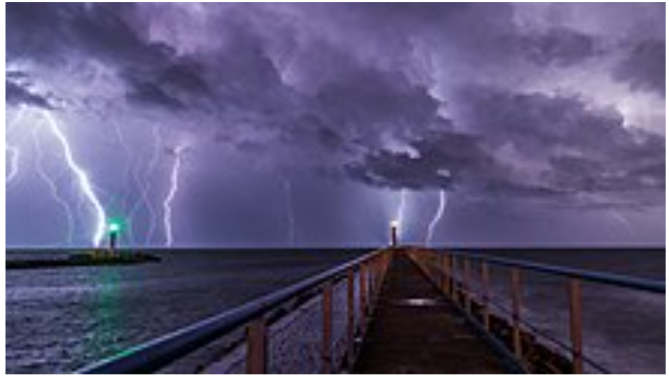
Strokes of cloud-to-ground lightning strike the ocean off of Port-la-Nouvelle in southern France. Source, Orage PLN.
Author, Maxime Raynal from France.
Electrification..
The details of the charging process are still being studied by scientists, but there is general agreement on some of the basic concepts of thunderstorm electrification. Electrification can be by the triboelectric effect as a result of ion transfer between colliding bodies. Uncharged, colliding water-drops can become charged because of charge transfer between them (as aqueous ions) in an electric field as would exist in a thunder cloud.
The main charging area in a thunderstorm occurs in the central part of the storm where air is moving upward rapidly (updraft) and temperatures range from −15 to −25 °C (5 to −13 °F); see Figure 1. In that area, the combination of temperature and rapid upward air movement produces a mixture of super-cooled cloud droplets (small water droplets below freezing), small ice crystals, and graupel (soft hail). The updraft carries the super-cooled cloud droplets and very small ice crystals upward. At the same time, the graupel, which is considerably larger and denser, tends to fall or be suspended in the rising air.
The differences in the movement of the precipitation cause collisions to occur.
When the rising ice crystals collide with graupel, the ice crystals become positively charged and the graupel becomes negatively charged; see Figure 2. The updraft carries the positively charged ice crystals upward toward the top of the storm cloud. The larger and denser graupel is either suspended in the middle of the thunderstorm cloud or falls toward the lower part of the storm.
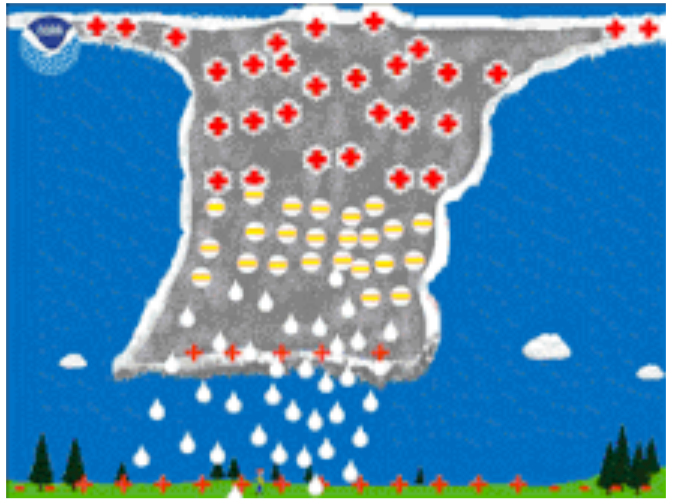
Author, U.S.A. governement.
The result is that the upper part of the thunderstorm cloud becomes positively charged while the middle to lower part of the thunderstorm cloud becomes negatively charged.
The upward motions within the storm and winds at higher levels in the atmosphere tend to cause the small ice crystals (and positive charge) in the upper part of the thunderstorm cloud to spread out horizontally some distance from the thunderstorm cloud base. This part of the thunderstorm cloud is called the anvil. While this is the main charging process for the thunderstorm cloud, some of these charges can be redistributed by air movements within the storm (updrafts and downdrafts).
In addition, there is a small but important positive charge buildup near the bottom of the thunderstorm cloud due to the precipitation and warmer temperatures.
The induced separation of charge in pure liquid water has been known since the 1840s as has the electrification of pure liquid water by the tribo-electric effect.
William Thomson (Lord Kelvin) demonstrated that charge separation in water occurs in the usual electric fields at the earth’s surface and developed a continuous electric field measuring device using that knowledge.
The physical separation of charge into different regions using liquid water was demonstrated by Kelvin with the Kelvin water dropper. The most likely charge-carrying species were considered to be the aqueous hydrogen ion and the aqueous hydroxide ion.
The electrical charging of solid water ice has also been considered. The charged species were again considered to be the hydrogen ion and the hydroxide ion.
An electron is not stable in liquid water with respect to a hydroxide ion plus dissolved hydrogen for the time scales involved in thunder storms.
The charge carrier in lightning is mainly electrons in a plasma. The process of going from charge as ions (positive hydrogen ion and negative hydroxide ion) associated with liquid water or solid water to charge as electrons associated with lightning must involve some form of electro-chemistry, that is, the oxidation and/or the reduction of chemical species.
As hydroxide functions as a base and carbon dioxide is an acidic gas, it is possible that charged water clouds in which the negative charge is in the form of the aqueous hydroxide ion, interact with atmospheric carbon dioxide to form aqueous carbonate ions and aqueous hydrogen carbonate ions.
The typical cloud-to-ground lightning flash culminates in the formation of an electrically conducting plasma channel through the air in excess of 5 km (3.1 mi) tall, from within the cloud to the ground’s surface. The actual discharge is the final stage of a very complex process.
At its peak, a typical thunderstorm produces three or more strikes to the Earth per minute. Lightning primarily occurs when warm air is mixed with colder air masses, resulting in atmospheric disturbances necessary for polarizing the atmosphere.[citation needed] However, it can also occur during dust storms, forest fires, tornadoes, volcanic eruptions, and even in the cold of winter, where the lightning is known as thundersnow.
Hurricanes typically generate some lightning, mainly in the rainbands as much as 160 km (99 mi) from the center.
Distribution, Frequency and Extent.
Lightning is not distributed evenly around Earth, as shown in the map.
On Earth, the lightning frequency is approximately 44 (± 5) times per second, or nearly 1.4 billion flashes per year and the average duration is 0.2 seconds made up from a number of much shorter flashes (strokes) of around 60 to 70 microseconds.
Many factors affect the frequency, distribution, strength and physical properties of a typical lightning flash in a particular region of the world. These factors include ground elevation, latitude, prevailing wind currents, relative humidity, and proximity to warm and cold bodies of water.
To a certain degree, the proportions of intra-cloud, cloud-to-cloud, and cloud-to-ground lightning may also vary by season in middle latitudes.
Because human beings are terrestrial and most of their possessions are on the Earth where lightning can damage or destroy them, cloud-to-ground (CG) lightning is the most studied and best understood of the three types, even though in-cloud (IC) and cloud-to-cloud (CC) are more common types of lightning.
Lightning’s relative unpredictability limits a complete explanation of how or why it occurs, even after hundreds of years of scientific investigation. About 70% of lightning occurs over land in the tropics where atmospheric convection is the greatest.
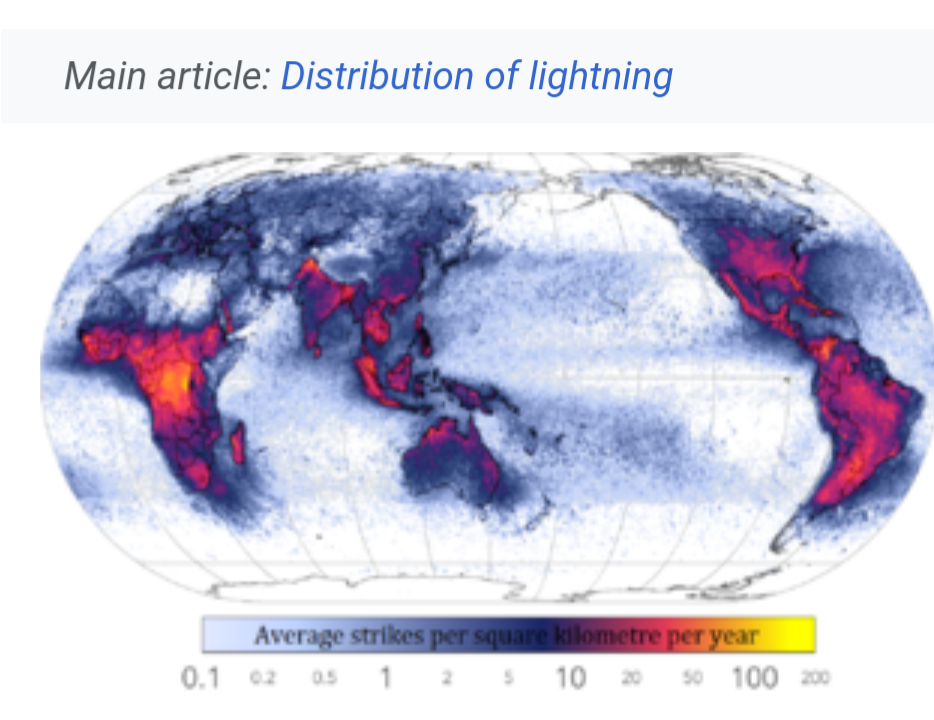
World map showing the frequency of lightning strikes, in flashes per km² per year (equal-area projection), from combined 1995–2003 data from the Optical Transient Detector and 1998–2003 data from the Lightning Imaging Sensor.
Description, Frequency of lightning strikes throughout the world, based on data from NASA. Author, Citynoise (talk).
This occurs from both the mixture of warmer and colder air masses, as well as differences in moisture concentrations, and it generally happens at the boundaries between them.
The flow of warm ocean currents past drier land masses, such as the Gulf Stream, partially explains the elevated frequency of lightning in the Southeast United States. Because large bodies of water lack the topographic variation that would result in atmospheric mixing, lightning is notably less frequent over the world’s oceans than over land. The North and South Poles are limited in their coverage of thunderstorms and therefore result in areas with the least lightning.
In general, CG lightning flashes account for only 25% of all total lightning flashes worldwide. Since the base of a thunderstorm is usually negatively charged, this is where most CG lightning originates. This region is typically at the elevation where freezing occurs within the cloud. Freezing, combined with collisions between ice and water, appears to be a critical part of the initial charge development and separation process.
During wind-driven collisions, ice crystals tend to develop a positive charge, while a heavier, slushy mixture of ice and water (called graupel) develops a negative charge. Updrafts within a storm cloud separate the lighter ice crystals from the heavier graupel, causing the top region of the cloud to accumulate a positive space charge while the lower level accumulates a negative space charge.
Because the concentrated charge within the cloud must exceed the insulating properties of air, and this increases proportionally to the distance between the cloud and the ground, the proportion of CG strikes (versus CC or IC discharges) becomes greater when the cloud is closer to the ground. In the tropics, where the freezing level is generally higher in the atmosphere, only 10% of lightning flashes are CG. At the latitude of Norway (around 60° North latitude), where the freezing elevation is lower, 50% of lightning is CG.
Lightning is usually produced by cumulonimbus clouds, which have bases that are typically 1–2 km (0.62–1.24 mi) above the ground and tops up to 15 km (9.3 mi) in height.
The place on Earth where lightning occurs most often is near the small village of Kifuka in the mountains of the eastern Democratic Republic of the Congo, where the elevation is around 975 m (3,200 ft).
On average, this region receives 158 lightning strikes per square kilometre per year (410/sq mi/yr). Lake Maracaibo in Venezuela averages 297 days per year with lightning activity, an effect recognized as Catatumbo lightning. Other lightning hotspots include Singapore and Lightning Alley in Central Florida.

The world record megaflash, stretching 477 miles from Texas to Mississippi, captured by GOES-16 on 29 April 2020 at 14:32:39 UTC. {{citation |title=New WMO Certified Megaflash Lightning Extremes for Flash Distance (768 km) and Duration (17.01 seconds) Recorded from Space |author=Randall Cerveny et al |doi=10.1175/BAMS-D-21-0254.1 |journal=Bulletin of the American Meteorological Society |date=1 February 2022}}.
According to the United Nations’ WMO, on April 29, 2020, a bolt 768 km (477.2 mi) long was observed in the southern U.S.—sixty km (37 mi) longer than the previous distance record (southern Brazil, October 31, 2018).
A single flash in Uruguay and northern Argentina on June 18, 2020 lasted for 17.1 seconds—0.37 seconds longer than the previous record (March 4, 2019, also in northern Argentina).
Necessary Conditions.
In order for an electrostatic discharge to occur, two preconditions are necessary: first, a sufficiently high potential difference between two regions of space must exist, and second, a high resistance medium must obstruct the free, unimpeded equalization of the opposite charges. The atmosphere provides the electrical insulation, or barrier, that prevents free equalization between charged regions of opposite polarity.
It is well understood that during a thunderstorm there is charge separation and aggregation in certain regions of the cloud; however, the exact processes by which this occurs are not fully understood.
Electrical Field Generation.
As a thundercloud moves over the surface of the Earth, an equal electric charge, but of opposite polarity, is induced on the Earth’s surface underneath the cloud. The induced positive surface charge, when measured against a fixed point, will be small as the thundercloud approaches, increasing as the center of the storm arrives and dropping as the thundercloud passes. The referential value of the induced surface charge could be roughly represented as a bell curve.
The oppositely charged regions create an electric field within the air between them. This electric field varies in relation to the strength of the surface charge on the base of the thundercloud – the greater the accumulated charge, the higher the electrical field.
Flashes and Strikes.
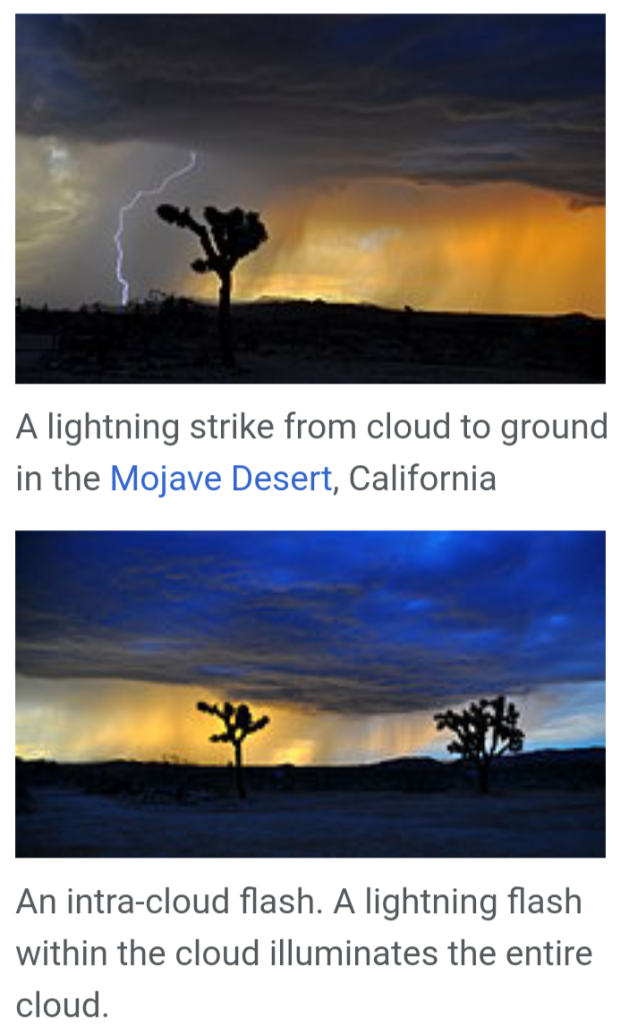
1.) Violent electrical storm at sunset, attacks the California Mojave Desert
Date16 October 2015, 08:07:11
2.) Lightning within the cloud illuminates the entire cloud blanket over the Mojave Desert during an electrical rain storm.
Date, Taken on 15 October 2015, 17:11:33
Source, Own work for both photographs.
Author, Jessie Eastland.
The best-studied and understood form of lightning is cloud to ground (CG) lightning. Although more common, intra-cloud (IC) and cloud-to-cloud (CC) flashes are very difficult to study given there are no “physical” points to monitor inside the clouds. Also, given the very low probability of lightning striking the same point repeatedly and consistently, scientific inquiry is difficult even in areas of high CG frequency.
Lightning Leaders.
In a process not well understood, a bidirectional channel of ionized air, called a “leader”, is initiated between oppositely-charged regions in a thundercloud. Leaders are electrically conductive channels of ionized gas that propagate through, or are otherwise attracted to, regions with a charge opposite of that of the leader tip. The negative end of the bidirectional leader fills a positive charge region, also called a well, inside the cloud while the positive end fills a negative charge well. Leaders often split, forming branches in a tree-like pattern.
In addition, negative and some positive leaders travel in a discontinuous fashion, in a process called “stepping”. The resulting jerky movement of the leaders can be readily observed in slow-motion videos of lightning flashes.
It is possible for one end of the leader to fill the oppositely-charged well entirely while the other end is still active. When this happens, the leader end which filled the well may propagate outside of the thundercloud and result in either a cloud-to-air flash or a cloud-to-ground flash. In a typical cloud-to-ground flash, a bidirectional leader initiates between the main negative and lower positive charge regions in a thundercloud. The weaker positive charge region is filled quickly by the negative leader which then propagates toward the inductively-charged ground.
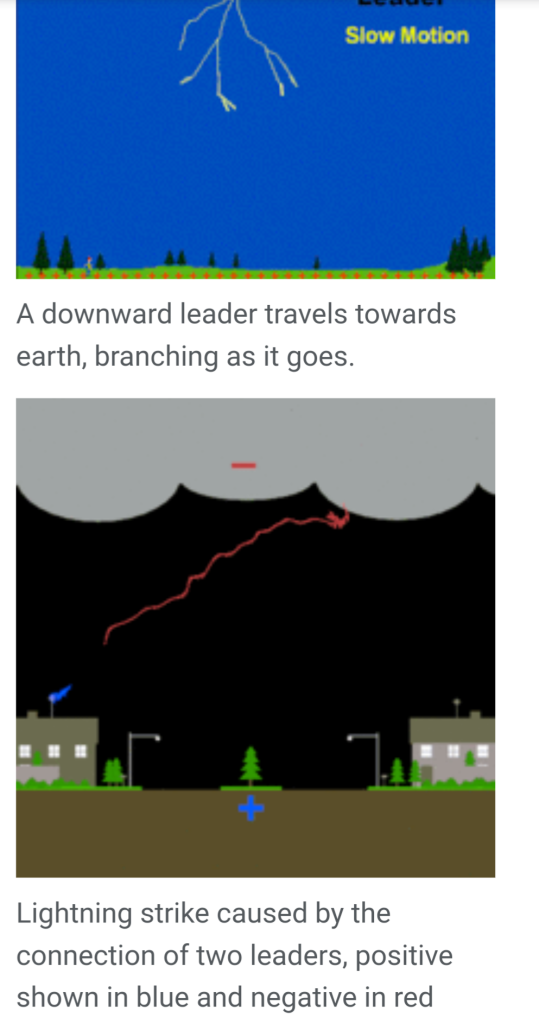
1.) negative charges going to the ground.
Author, NOAA.
2.) An illustration of how lightning occurs when the negatively charged electrons from the cloud (the lower part) leaps when the positively charged electrons from the ground attracts it.
Author, Anynobody.
The positively and negatively charged leaders proceed in opposite directions, positive upwards within the cloud and negative towards the earth. Both ionic channels proceed, in their respective directions, in a number of successive spurts. Each leader “pools” ions at the leading tips, shooting out one or more new leaders, momentarily pooling again to concentrate charged ions, then shooting out another leader. The negative leader continues to propagate and split as it heads downward, often speeding up as it gets closer to the Earth’s surface.
About 90% of ionic channel lengths between “pools” are approximately 45 m (148 ft) in length. The establishment of the ionic channel takes a comparatively long amount of time (hundreds of milliseconds) in comparison to the resulting discharge, which occurs within a few dozen microseconds.
The electric current needed to establish the channel, measured in the tens or hundreds of amperes, is dwarfed by subsequent currents during the actual discharge.
Initiation of the lightning leader is not well understood. The electric field strength within the thundercloud is not typically large enough to initiate this process by itself. Many hypotheses have been proposed. One hypothesis postulates that showers of relativistic electrons are created by cosmic rays and are then accelerated to higher velocities via a process called runaway breakdown.
As these relativistic electrons collide and ionize neutral air molecules, they initiate leader formation. Another hypothesis involves locally enhanced electric fields being formed near elongated water droplets or ice crystals.[40] Percolation theory, especially for the case of biased percolation, describes random connectivity phenomena, which produce an evolution of connected structures similar to that of lightning strikes. A streamer avalanche model has recently been favored by observational data taken by LOFAR during storms.
Upward Streamers.
When a stepped leader approaches the ground, the presence of opposite charges on the ground enhances the strength of the electric field. The electric field is strongest on grounded objects whose tops are closest to the base of the thundercloud, such as trees and tall buildings. If the electric field is strong enough, a positively charged ionic channel, called a positive or upward streamer, can develop from these points. This was first theorized by Heinz Kasemir.
As negatively charged leaders approach, increasing the localized electric field strength, grounded objects already experiencing corona discharge will exceed a threshold and form upward streamers.
Attachment.
Once a downward leader connects to an available upward leader, a process referred to as attachment, a low-resistance path is formed and discharge may occur. Photographs have been taken in which unattached streamers are clearly visible. The unattached downward leaders are also visible in branched lightning, none of which are connected to the earth, although it may appear they are. High-speed videos can show the attachment process in progress.
Discharge.
Return stroke.
Once a conductive channel bridges the air gap between the negative charge excess in the cloud and the positive surface charge excess below, there is a large drop in resistance across the lightning channel. Electrons accelerate rapidly as a result in a zone beginning at the point of attachment, which expands across the entire leader network at up to one third of the speed of light. This is the “return stroke” and it is the most luminous and noticeable part of the lightning discharge.
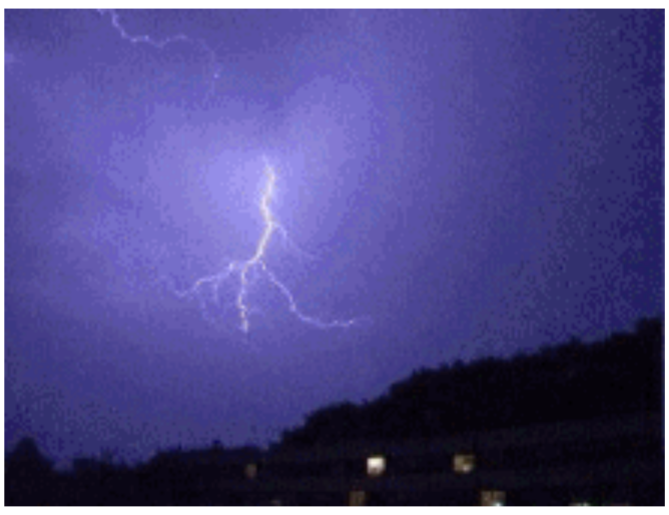
Author,
Sebastien D’ARCO, animation by Koba-chan.
A large electric charge flows along the plasma channel, from the cloud to the ground, neutralising the positive ground charge as electrons flow away from the strike point to the surrounding area. This huge surge of current creates large radial voltage differences along the surface of the ground.
Called step potentials, they are responsible for more injuries and deaths in groups of people or of other animals than the strike itself. Electricity takes every path available to it. Such step potentials will often flow through one leg and out another, electrocuting an unlucky human or animal standing near the point where the lightning strikes.
The electric current of the return stroke averages 30 kiloamperes for a typical negative CG flash, often referred to as “negative CG” lightning. In some cases, a ground-to-cloud (GC) lightning flash may originate from a positively charged region on the ground below a storm. These discharges normally originate from the tops of very tall structures, such as communications antennas. The rate at which the return stroke current travels has been found to be around 100,000 km/s (one-third of the speed of light).
The massive flow of electric current occurring during the return stroke combined with the rate at which it occurs (measured in microseconds) rapidly superheats the completed leader channel, forming a highly electrically conductive plasma channel. The core temperature of the plasma during the return stroke may exceed 50,000 K, causing it to radiate with a brilliant, blue-white color.
Once the electric current stops flowing, the channel cools and dissipates over tens or hundreds of milliseconds, often disappearing as fragmented patches of glowing gas. The nearly instantaneous heating during the return stroke causes the air to expand explosively, producing a powerful shock wave which is heard as thunder.
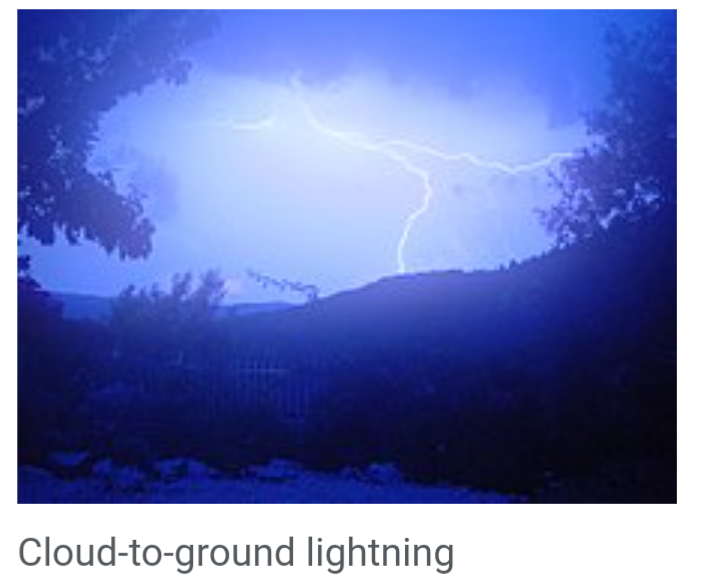
Lightning strikes a mountain top.
Date, September 2002
Source, Own work
Author, Yintan.
Re Strike.
High-speed videos (examined frame-by-frame) show that most negative CG lightning flashes are made up of 3 or 4 individual strokes, though there may be as many as 30.[53]
Each re-strike is separated by a relatively large amount of time, typically 40 to 50 milliseconds, as other charged regions in the cloud are discharged in subsequent strokes. Re-strikes often cause a noticeable “strobe light” effect.
To understand why multiple return strokes utilize the same lightning channel, one needs to understand the behavior of positive leaders, which a typical ground flash effectively becomes following the negative leader’s connection with the ground.
Positive leaders decay more rapidly than negative leaders do. For reasons not well understood, bidirectional leaders tend to initiate on the tips of the decayed positive leaders in which the negative end attempts to re-ionize the leader network. These leaders, also called recoil leaders, usually decay shortly after their formation. When they do manage to make contact with a conductive portion of the main leader network, a return stroke-like process occurs and a dart leader travels across all or a portion of the length of the original leader. The dart leaders making connections with the ground are what cause a majority of subsequent return strokes.
Each successive stroke is preceded by intermediate dart leader strokes that have a faster rise time but lower amplitude than the initial return stroke. Each subsequent stroke usually re-uses the discharge channel taken by the previous one, but the channel may be offset from its previous position as wind displaces the hot channel.
Since recoil and dart leader processes do not occur on negative leaders, subsequent return strokes very seldom utilize the same channel on positive ground flashes which are explained later in the article.
Transient currents during flash.
The electric current within a typical negative CG lightning discharge rises very quickly to its peak value in 1–10 microseconds, then decays more slowly over 50–200 microseconds.
The transient nature of the current within a lightning flash results in several phenomena that need to be addressed in the effective protection of ground-based structures. Rapidly changing currents tend to travel on the surface of a conductor, in what is called the skin effect, unlike direct currents, which “flow-through” the entire conductor like water through a hose. Hence, conductors used in the protection of facilities tend to be multi-stranded, with small wires woven together. This increases the total bundle surface area in inverse proportion to the individual strand radius, for a fixed total cross-sectional area.
The rapidly changing currents also create electromagnetic pulses (EMPs) that radiate outward from the ionic channel. This is a characteristic of all electrical discharges. The radiated pulses rapidly weaken as their distance from the origin increases. However, if they pass over conductive elements such as power lines, communication lines, or metallic pipes, they may induce a current which travels outward to its termination.
The surge current is inversely related to the surge impedance: the higher in impedance, the lower the current.[57] This is the surge that, more often than not, results in the destruction of delicate electronics, electrical appliances, or electric motors. Devices known as surge protectors (SPD) or transient voltage surge suppressors (TVSS) attached in parallel with these lines can detect the lightning flash’s transient irregular current, and, through alteration of its physical properties, route the spike to an attached earthing ground, thereby protecting the equipment from damage.
Types.
Three primary types of lightning are defined by the “starting” and “ending” points of a flash channel.
Intra-cloud (IC) or in-cloud lightning occurs within a single thundercloud unit.
Cloud-to-cloud (CC) or inter-cloud lightning starts and ends between two different “functional” thundercloud units.
Cloud-to-ground (CG) lightning primarily originates in the thundercloud and terminates on an Earth surface, but may also occur in the reverse direction, that is ground to cloud.
There are variations of each type, such as “positive” versus “negative” CG flashes, that have different physical characteristics common to each which can be measured.
Different common names used to describe a particular lightning event may be attributed to the same or to different events.
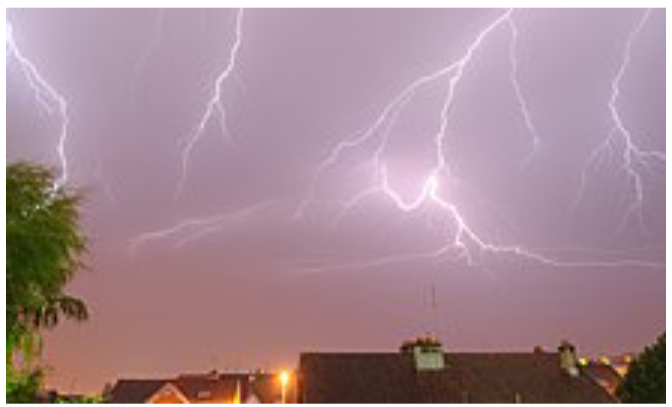
Photo Author, This photo was taken by Thomas Bresson.
Courtesy, Wikipedia.
( CC BY-SA 3.0 unless otherwise noted )

